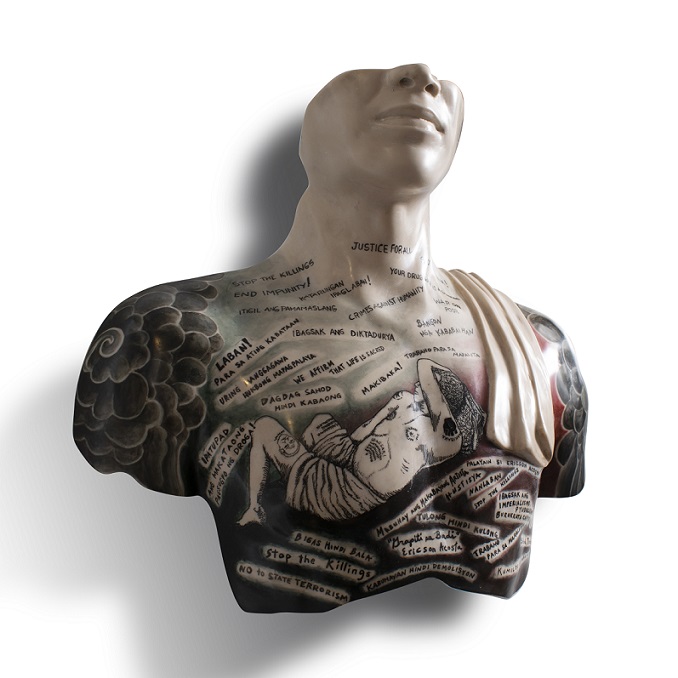Photos courtesy of Galerie Stephanie

In her latest exhibition “Chronicles on Skin” at Galerie Stephanie, sculptor Julie Lluch combines sculpture with painting, incorporating “tattoos” in acrylic on her coldcast marble creations. That is not an easy feat because the marble is so smooth the paint slides off. The artist had to keep at it for the paint to adhere.
This tattoo style was brought about by the initial shock she had “after seeing the ghastly photographs of victims of the drug war shown to me by my friends, human rights volunteers engaged in documentation. The tattoos on the cadavers were crude and horrifying, mostly images of skulls, skeletons, dragons, hellfire, demons and a lot of obscenities. There were sentimental ones of hearts pierced by an arrow, Jesus with a crown of thorns, names of wife or sweetheart, slogans, etc.”
She said, “I would have gone for the wild and visceral images which were powerful but realized that the host base, the sculpture torso, is classical and beauteous and the two contrasting elements would not complement each other. There was so much I needed to study about tattoos across cultures, classes, tribes, fashion, and I am just glad to have managed to incorporate them somehow as part of the paintings.”

Preparation and execution took a little over four months which she said was “so short a time. I wish I could have done more.”
Still, the overall effect is stunning like coming upon a series of new Lluchs that have a tactile appeal. One wishes the gallery would allow the viewers to touch the artworks.
Lluch said, “The idea of something new, something I haven’t tried before like painting on sculpture, challenged me, but I did not foresee the difficulty that lay ahead. Then the thought of actually engaging in activist work, being allied with the people’s movement that seeks redress and justice for the victims of state-sponsored killings goaded me on, even if I’m outside of the actual movement. I have always wanted to be part of it, but being senior, I can’t wave flags and carry banners or march in the sun anymore.”

She has found inspiration in “the men and women who are working quietly and faithfully for the cause of the helpless and downtrodden and poor victims of state brutality, who are fearless and passionate, putting even their lives on the line. I know many of them.”
Another source of inspiration is Juan Luna’s mural “Spoliarium.” She explained, “Luna has done a marvelous thing, and I would like to honor him in my own way. The image of the ‘Spoliarium’ becomes the leitmotif throughout the exhibition, the symbol of the country in travail or vanquished by a ruling master.”
In the past, she had painted on her sculptures whether terra cotta or marble. “But the painting here is quite different because it carries the narrative independently of the sculpture . The sculpture, which is the host/base is static, immovable, a bit of aesthetic concern here. This caused me some unprecedented difficulty. Besides, the cast marble is so shiny smooth the paint didn’t easily stay on the surface, requiring some special technique and a lot of patience. But the effect of acrylic on marble was so lovely!”

Her daughters, all artists with different degrees of engagement in activism, make her feel fortunate. “My family members are in that same trajectory together while pursuing our individual paths/careers in art, be it painting, sculpture, film, installation or music. Our engagement may not be to the extent that we fear for life, except in Kiri’s case at some point, but it is such a privilege to serve in any way. It is its own reward.”
Asked to comment on the state of the nation, she said, “I am deeply disappointed with our country. I ask questions like where did we go wrong? But the answers are not forthcoming. I still love my country in spite of everything, I need to love it more in spite the exhaustion. Like the psalmist I pray: ‘How long , O Lord; how long?’”
In a number of works in the exhibit, 16 of them, she grieves and mourns “the state of our country and our mangled history, specifically the thousands of killings across the land.”

The painted images are from her old works like “Picasso y Yo,” “Georgia Bull” or “The Piscean Deluge” to express her personal anguish.” She borrowed from the late painter Pablo Baens Santos’ “Weeping Woman” and a nude male which she used as a symbol of the “Spirit of the Filipino Artist” in defiance of oppressive and unrighteous governance. She also put to good use the iconic picture of the photographer Raffy Lerma to denounce the killings .
She added “In the works, it is the women who are shown weeping over the dead body of husband, son or father. Yes, it is the woman’s role to mourn. So be it.”
“Chronicles on Skin” runs from March 17 to April 3 at Galerie Stephanie located on the fourth level of the east wing, Shangri-la Plaza Mall, Mandaluyong City.